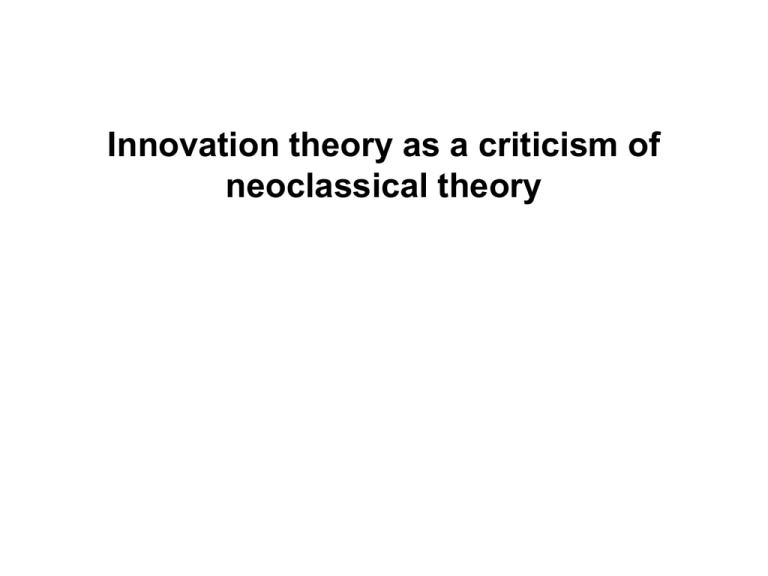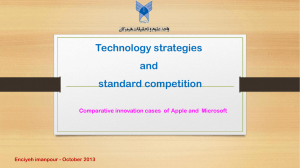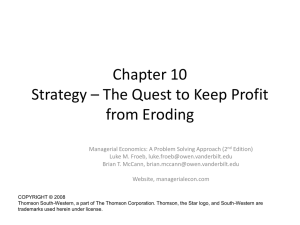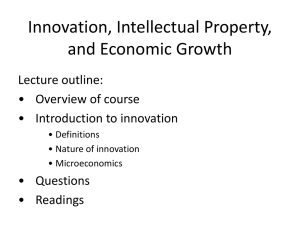Innovation theories (4) - Unchain-vu
advertisement

Innovation theory as a criticism of neoclassical theory Criticisms of the neoclassical model of the firm: • Impressively rigorous but how relevant in practice? Maximization under clearly defined (and known in advance) constraints; assumptions that simplify mathematics • Firm tends to remain a black box; more interest in markets than in firms • Technology is given exogenously • Rational and fully informed actors • Self-interested behaviour; everybody in the firm acts in the firm's interest (firm is like a person) Attempts to get things more realistic (at the expense of rigour?) Explicit recognition of risks and uncertainties: • Risk: A probability distribution is known • Uncertainty: You are unable to attach probabilities to future outcomes from an action (strong uncertainty: you do not know what you do not know) • Incomplete information: In many cases it is rational not to be fully informed! Why? →Think of the neo-classical rule of profit maximization (MR=MC). Assume that getting informed is an economic activity with marginal costs (MC) and marginal revenues (MR) … Moreover, the value of information to be collected can be assessed only once the information costs are incurred (uncertainty about MR!) Instrumental rationality versus bounded rationality: Instrumental rationality: • The choice of the best means to specified ends. Bounded rationality (Herbert Simon): • Decision-making is influenced by the limited cognitive capacity of actors. Firms are unable to maximise; they are 'satisficing'; they stop searching for better solutions once they have found a satisfactory solution. Routines in evolutionary theory: • Definition: A routine is a regular and predictable behaviour pattern • Business decision making is skilled behaviour, comparable to driving a car. It involves large amounts of learned skills, as well as limited amounts of immediate calculation. • Management involves "internalized skills"; skilful behaviour has become "automatic", routed in the firm's history, culture and social milieu. Danger of routines: • Managers may display response patterns, drawing on internalized knowledge and skills, after the environment for which they were appropriate has changed. Note that history matters: • Cultures, experiences and "how we do things here" develop in time and constrain the present. They cause path dependency: past experience determines what the firm "is good at"; it shapes ways of decision-making and closes off options. Firms may be trapped into inefficient behaviour by long-past influences and decisions. Technological change Angus Maddison's estimates of total World production of goods and services: During 320 years preceding 1820 → Increase by a factor 3 During 180 years after 1820 → Increase by a factor 60 New questions: Why has industrial capitalism been so successful? Which factors drive or hamper innovation? Are some types of capitalism (e.g. the corporatist 'Rhineland' model) better than others (e.g. the Anglo-Saxon 'free market' model)? The neo-classical approach to growth accounting: A classical article by Robert Solow (1957): About 80% of growth in the period 1909-1949 in the US cannot be explained by growth of labour or capital; it must be due to "technical change" ... … but "technical change" remained a "black box"! Critique: • "Technical change" is what is unexplained (i.e. the "residual" or the "coefficient of ignorance") Criticism on Solow: • No account of education and training of labour force • No account of differences in the quality of capital • Solow ignored economies of scale: Cost reduction from producing at a larger scale • Solow ignored economies of scope: Cost reduction due to savings on R&D by producing technically related products • Solow ignored 'learning-by-doing': Cost reduction due to experience • Solow assumes that all firms operate at the technological frontier; they can tap into the stock of knowledge and use whichever technology they choose (perfect knowledge). Change of focus in economics: From the neo-classical question: • "Given available technologies, how can we allocate resources most efficiently?" (static efficiency) … to the evolutionary question: • "How can we achieve fast technological progress?" (dynamic efficiency) Towards a "direct" investigation of technical change: David S. Landes (The unbound Prometheus) Key conclusions: • At the heart of the industrial revolution is substitution of mechanical devices for human skills • Substitution of inanimate power (steam) for human and animal strength • Marked improvement in raw materials production and use • Key factor: Introduction of machines, leading to unprecedented productivity growth Towards a "direct" investigation of technical change (1): • Innovations "came in a sequence of challenge and response, in which the speed-up of one stage of the manufacturing process placed a heavy strain on the factors of production in one or more other stages and called forth innovations to correct the imbalance' (David S. Landes: The unbound Prometheus, CUP, p. 84). Innovations create new bottlenecks and new opportunities elsewhere. • Important are not only the major breakthroughs but also the innumerable adjustments and improvements that follow them. Towards a "direct" investigation of technical change (2) • Historical path dependencies count: Accumulation of knowledge requires (time-consuming) learning and R&D investment; what a firm is "good at" depends on its past learning through product and process development; a firm's historically grown knowledge base determines (and limits) successful future choices for innovative investment → knowledge is not freely available to perfectly informed agents. • There are from time to time "pervasive" (general purpose) technologies that become relevant not just for one sector, but also for several others or even to the entire economy (steam, electricity, new materials). Progress in one sector is crucial for progress in others. Towards a "direct" investigation of technical change (3) • Many firms are (far) distant from the best-practicefrontier (Production possibility curve): There are significant differences in productivity between firms in the same industries • "Tacit" knowledge can be crucial. Tacit knowledge is ill-documented, ill-codified, implicit (in the finger tops of people), based on personal experience. Its tacit character limits the transfer of knowledge across geographical distance. Towards a "direct" investigation of technical change (4) • It is unrealistic assuming perfect knowledge. Innovations are expensive, time-consuming and uncertain; they involve trial and error, failures and dead ends. Technical and commercial uncertainty can lead to under-investment in innovation. There is no 'linear' sequence: Basic research→ applied research→ invention→ development→ production→ marketing. • Uncertainty can be aggravated by the "sunk costs" character of innovative investments: they are quite specific and often irreversible. Towards a "direct" investigation of technical change (5) • Firms are not so free to choose; they can be 'lockedin' (in inferior technologies), due to 'sunk costs' due to past investments or standards. • Markets tend towards under-investment in R&D since firms cannot fully appropriate innovation benefits (positive externalities). This is due to the 'public goods' character of technological knowledge (non-rival, non-excludable). • R&D projects involve indivisibilities: High fixed costs, negligible marginal costs (strong economies of scale)→ imperfect markets! Towards a "direct" investigation of technical change (6) • Innovations are rarely an isolated episode but are embedded in a 'technological trajectory'. Major technological breakthroughs can be followed by numerous incremental product and process improvements. • Successful innovation in one industry often depends on progress in other industries, requiring interaction with other parties (suppliers, clients, public research institutions) Why does not everybody innovate? • 'Sailing ship' effect? (Power of vested interests: emergence of the steam ship triggered improvements in sailing ships) • Technological opportunity (Sector-specific factors) • Firm-specific knowledge/competencies (Path dependency due to accumulated 'tacit' knowledge) • Economic inducements (Bottlenecks, local demand, input prices, competitive rivalry) Appropriation of innovation benefits: • Secrecy: Never perfect; more efficient for process than for product innovation • Accumulated tacit knowledge = Un-codified, illdocumented, idiosyncratic knowledge, based on personal experience (keep your qualified personnel!) • Lead times on competitors • Establish brand loyalty and credibility; exploit customer feedback for improvements; • The learning curve (learning-by-doing) • Complementary assets, e.g. marketing and aftersales-services • Standards, e.g. IBM vs. Apple • Patent protection: More efficient for product than for process innovation The economics of the patent system (I) Advantages of a patent system: • Well-defined and protected property rights • A database on the current state of knowledge • Monopoly profits give an incentive for further development, but also for 'inventing around' by others • Facilitates financing of developments and of largescale investment The economics of the patent system (II) Disadvantages of a patent system: • Monopolies lead to welfare losses • De facto cartels through (cross) licensing • Waste due to 'inventing around', notably in cases of 'fencing in' technology by means of numerous fringe patents • Large firms can 'squeeze' small firms in protracted lawsuits • Other means of protection may be more efficient (time-lead, secrecy, tacit knowledge) Why selling licenses on patents? • Reduce costs and risks of production and distribution • Reach a larger market • Exploit in other applications • Establish standards • Gain access to complementary technology • Block competing developments: Convert a competitor into a defender of your product Five major technological trajectories: • Supplier-dominated innovators • Scale-intensive innovators • Science-based innovators • Information-intensive innovators • Specialized suppliers → These five types of innovators differ substantially Supplier-dominated innovators: Typical sectors: • Agriculture, traditional manufacturing and services Main sources of technology: • Little R&D (rather process-oriented than productrelated R&D); equipment bought from suppliers; production learning Main tasks of technology strategy: • Exploit non-technological advantages; adopt IT and other equipment offered by suppliers; respond flexibly to user needs. Scale-intensive innovators: Typical sectors: • Bulk materials; consumer durables; automobiles; civil engineering Main sources of technology: • Production engineering; Production learning; suppliers; design offices Main tasks of technology strategy: • Managing safe and complex products and processes • Managing incremental improvements; adopt best practices Science-based innovators: Typical sectors: • Electronics, chemicals Main sources of technology: • R&D, basic research Main tasks of technology strategy: • Exploit economies of scope • Exploit basic science; collaborate with universities Information-intensive innovators: Typical sectors: • Finance, Retail, Publishing, Travel Main sources of technology: • Software and systems departments; suppliers Main tasks of technology strategy: • New products and services; design and operation of complex information processing systems; match ITbased opportunities with user needs Specialized suppliers: Typical sectors: • Mechanical engineering; instruments; software Main sources of technology: • Design; advanced users Main tasks of technology strategy: • Monitor users and maintain strong links with lead users; match technologies to user needs; Ignoring uncertainty: Rationalist school (Victor Ansoff) Analogy with military strategy: (1) Describe, understand and analyze environment (2) Determine course of action (3) Carry out action Corporate equivalent: →SWOT: Analysis of corporate strengths and weaknesses in the light of external opportunities and threats. →Weak in a complex, fast changing environment and under imperfect information The difficulty with "strategic" thinking: • The war in Vietnam is going well and will succeed (R. McNamara, 1963) • I think there is a world market for about five computers (T. Watson, 1948) • Prediction is very difficult, especially about the future (N. Bohr) • I cannot conceive of any vital disaster happening to this vessel (Captain of Titanic, 1912) Alternative: An Incrementalist Strategy (1) Make deliberate steps – measure and evaluate – adjust objectives (if necessary) and decide on next steps Design – development – test – adjust design – retest – operate Incrementalist Strategy (2) Implications for corporate strategy: (1) Corporatist strategy should be seen as a form of corporate learning, from analyses and experience, how to cope more effectively with complexity and change (1) Successful management practice is never fully reproducible Incrementalist Strategy (3) Implications for strategy formation: • Explore implications of a range of possible (but uncertain) future trends • Ensure broad participation and informal channels of communication • Use multiple sources of information, debate and scepticism • Expect to change strategies in the light of new (often unexpected) evidence Michael Porter (1) Five forces driving industry competition: • • • • • Relations with suppliers Relations with buyers New entrants Substitute products Rivalry amongst established firms Threats and opportunities in Porter’s analysis (1) Potential entrants and substitute products: • Threat is increased by poor economies of scale and / or poor learning effects; and by substitute products • Threat is decreased by ‘lock-in’ to technological standards or through patent protection Threats and opportunities in Porter’s analysis (2) Power of suppliers and buyers: • • Increases with the dependence on innovations that are essential to your inputs Decreases by innovations that reduce technological dependence on suppliers Threats and opportunities in Porter’s analysis (3) Rivalry amongst established firms: • Market power can be established by innovation, but it can also be destroyed by imitation Porter’s generic technology strategies (1) Choose between “Cost leadership” and “Differentiation” strategy Porter’s generic technology strategies (2) “Cost leadership” (minimize costs): • Lower material inputs • Ease of manufacture • Improve logistics • Minimum features • Exploit economies of scale • Exploit learning-by-doing Porter’s generic technology strategies (3) “Differentiation” strategy: • Enhance quality and features (niche markets) • Deliverability • Precision and quality control • Response time Porter’s generic technology strategies (4) (1) Choose between cost leadership and differentiation (2) Also choose between “Innovation Leadership” and “Innovation Followership” Porter’s generic technology strategies (5) “Innovation Leadership” Strong commitment to: Creativity, risk-taking and R&D Close linkages with major sources of new knowledge and Needs and responses of customers Porter’s generic technology strategies (6) “Innovation Followership” Strong commitment to: Competitor analysis and intelligence Reverse engineering Cost cutting and production learning Porter’s generic technology strategies (7) Weaknesses of Porter’s theory: Too close to ‘rationalist’ school: underestimates uncertainty (unexpected new technologies that change the rules of the game) Empirical evidence: ‘Stucking in the middle’ (between cost leadership and innovation) can be quite profitable You cannot always choose a strategy (firm size; tacit knowledge due to established product base) Problems with partial views of innovation (1) If innovation is only seen as … Strong R&D capability … the result can be: Technology fails to meet user needs Problems with partial views of innovation (2) If innovation is only seen as … The province of specialists in R&D laboratories … the result can be: Lack of involvement and knowledge / experience from others (e.g. clients, market research) Problems with partial views of innovation (3) If innovation is only seen as … Understanding and meeting customer needs … the result can be: Lack of technical progression (users demand what they know) Problems with partial views of innovation (4) If innovation is only seen as … Technology advances … the result can be: Producing products which customers do not want; designing processes which fail to meet user needs Problems with partial views of innovation (5) If innovation is only seen as … The province only of large firms … the result can be: Weak small firms with too high a dependence on large customers Problems with partial views of innovation (6) If innovation is only seen as … Only about “breakthrough” changes … the result can be: Neglect of potential of incremental innovation Problems with partial views of innovation (7) If innovation is only seen as … Only associated with key individuals … the result can be: Failure to utilize creativity of your entire organization Problems with partial views of innovation (8) If innovation is only seen as … Only internally generated … the result can be: 'Not invented here' effect Problems with partial views of innovation (10) If innovation is only seen as … Only externally generated … the result can be: Only externally generated Little internal learning; dependence on others Problems with partial views of innovation (11) If innovation is only seen as … Only concerning single firms … the result can be: Neglect of networking Uncertainty around R&D (1) Planning and financial assessment of R&D projects is almost impossible, because: • Project outcomes are uncertain • Different stages have different outcomes, requiring different methods of evaluation • Many crucial variables depend on expert judgement (there are no precise figures to be fitted into a formula) Uncertainty around R&D (2) Research by Edwin Mansfield shows that: • Managers and R&D workers can not predict accurately the development costs, time periods, markets and profits of R&D projects • Underestimation of time and costs: 140-280% for incremental improvements; 350-600% for major new products • More than half of all projects (and about half of R&D expenditures) are on failed projects • R&D scientists often are over-optimistic in their estimates. Uncertainty around R&D (3) How to deal with uncertainty? • Incrementalism: step-by-step modification of objectives and resources in the light of new evidence • Use simple rules (transparency) • Criteria for stopping a project should be made explicit from the beginning • Use sensitivity analysis (E.g. ‘What if costs double?’) • Try to reduce uncertainty before committing large sunk costs (‘learning before doing’). • Recognize that different types of R&D require different evaluation criteria Uncertainty around R&D (4) Three overlapping categories of R&D: • Knowledge building: Monitoring of technological environment; inexpensive; questions: which options or threats emerge? Can we afford (not) to enter certain fields? • Strategic positioning: Applied research and feasibility studies in order to reduce uncertainty and build in-house competence; live with high volatility of predictions and expectations; variety of evaluation methods that are more judgemental than rigorously quantitative. • Business investment: Division-level decision about commitment of large resources (sunk costs!). Emphasis on user needs and marketing. Careful monitoring and control of progress. Tight control of external links (Joint Ventures, ownership). Factors influencing diffusion (1) • Relative advantage: e.g. financial payback, convenience, satisfaction, social prestige • Compatibility: Consistency with values, experience, needs of potential adopters, their skills and practices, equipment, procedures and performance criteria; is it an 'all-or-nothing' option or can it be gradually implemented? How important are 'network externalities' and complementary innovations? • Complexity: Is it hard to understand? Does it require additional skills and knowledge? ("absorptive capacity" of user?) Factors influencing diffusion (2) • Triability: Experiments may reduce uncertainty • Observability: Epidemic model assumes spread by contact with other users • Future improvement potential: If you expected a rapid speed of technological change: postpone adoption? • External interests in diffusion: E.g. diffusion of medical technology crucially depends on doctors and hospitals; or insurance companies may insist on certain specifications National differences in innovation patterns Factors: Examples: Local buyers tastes Food and clothing in France and Italy Reliable machinery in Germany Private investment Automobile sector stimulating CAD and robots in Japan, Sweden and Germany Public investment Railways in France Medical instruments in Sweden Input prices Labour-saving innovations in high-wage countries Europe-US differences in automobile technology Environmental technology in Scandinavia Local natural resources Innovations in oil and gas; mineral ores, food and agriculture Innovation models: Schumpeter I and II Schumpeter I model: “Entrepreneurial model”: new firm foundation (e.g. in ICT, biotechnology); individual inventor-entrepreneur (“Garage business”). Schumpeter II model: “Routinized innovation model”: Incremental, stepwise innovations based on continuous accumulation of (tacit) knowledge; professionalized R&D labs in larger firms. Rhineland model versus Anglo-Saxon model Characteristics Anglo-Saxon Nippon-Rhineland Ownership Individuals, pension funds, insurers Individuals, companies, banks Control Dispersed; arm’s length Management Business Schools; accountants Concentrated, close and direct Engineers with business training Evaluation of R&D Published information Insider knowledge Strengths Responsive to radically new technological opportunities; Efficient use of capital Weaknesses Short-termism; Inability to evaluate firmspecific assets Higher priority to R&D than to dividends for shareholders; Remedial investment in failing firms Slow to deal with poor investment choices; Slow to exploit radically new technologies Factors behind sources and directions of technological change (1) Firm size: Typically big in chemicals, road vehicles, materials processing, aircraft and electronic products; typically small in machinery, instruments and software Type of product: Price sensitive in bulk materials and consumer products; performance sensitive in ethical drugs and machinery Objectives of innovation: Typically product innovation in ethical drugs and machinery; process innovation in steel; both in automobiles Factors behind sources and directions of technological change (2) Sources of innovation: Suppliers of equipment in agriculture and traditional industries; customers in instruments, machinery and software; in-house R&D in chemicals, electronics, transport, machinery, instruments and software; basic research in ethical drugs Locus of own innovation: R&D labs in chemicals and electronics, production engineering departments in automobiles and bulk materials, design offices in machine building; systems depart-ments in service industries (banking, supermarkets). Locating R&D: Corporate or divisional? Corporate level: Long time horizons; slow feedback loops; weak internal linkages; strong linkages to external knowledge sources; projects are relatively cheap Business unit level: Short time horizons; fast learning feedback loops; strong internal linkages with production and marketing; projects are relatively expensive Locating R&D: Corporate or divisional? Rules of thumb: R&D supporting existing businesses should be located in established divisions R&D supporting new businesses should initially be located in central labs, then transferred to divisions for exploitation R&D supporting foreign production should be located close to foreign production (adaptation of products to local conditions). Distinction between physical location and funding unit! Location and funding of R&D: Corporate or divisional? Corporate-level funding: Benefits are corporate-wide Divisional-level funding: Benefits are division-specific Corporate-level performance: Interfaces with advances in generic S&T Divisional-level performance: Interfaces with production, customers and suppliers Quadrant 1 Quadrant 2 Scanning external research; Assimilating and assessing radical new technologies Commercializing radical new technologies; Exploiting inter-divisional synergies Quadrant 3 Quadrant 4 Exploratory development of radical new technologies; Contract research for specific division problems Mainstream product & process development; Incremental improvements Criteria for centralized versus divisionalised R&D A firm’s main technological trajectory. Is the critical interface: • Between basic science and technology? (pharmaceuticals, chemistry) ⇛ Central lab + cooperation with universities • Between R&D (and design) and production? (automobiles, aircraft) ⇛ Division How young is the field? • New fields like biotechnology, need to be sheltered for some time against the pressure of immediate valorisation ⇛ Central lab + cooperation with universities Corporate style: • Short-run profit maximization (‘market-led strategy’) leads to emphasis on divisionalised R&D ⇛ Division R&D: global versus local Evidence from the World’s 359 largest firms: • On average, they perform about 12% of their innovative activities outside their home country (equivalent share of production: 25%) • Shares of foreign innovative activity are explained by shares of foreign production • Firms from smaller countries tend to have higher shares of foreign innovative activities • Foreign production tends to be less innovation-intensive than home production • Most of foreign innovative activities are performed in the USA and Europe (in fact: Germany). They are not globalised • Since the late 1980s, European firms (esp. from F, D and CH) have increasing shares of innovative activities in the US (⇛ tap into local skills and knowledge in IT and biotechnology)







